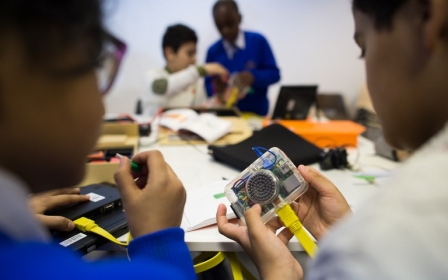UK police: We're sorry for 'Guess Who? Terrorism Edition'

British police have apologised for mocking up images of a "Terrorism Edition" of the board game "Guess Who?" in a presentation for children intended to challenge perceptions of "what a terrorist looks like".
The PowerPoint presentation was created in 2013 by officers at Greater Manchester Police as part of educational resources for use in delivering the government's Prevent counter-extremism strategy.
It was subsequently circulated to colleagues nationwide and endorsed by the Association of Chief Police Officers [now the National Police Chiefs Council] as an example of “good practice”, Middle East Eye can reveal.
The presentation includes an image of the "Guess Who?" logo over which the words "Terrorism Edition" have been emblazoned.
Another slide features an image of the "Guess Who?" board on which some of the characters have been replaced with photos of people who carried out or were convicted of plotting terrorism-related offences, including one of the 2005 London suicide bombers and an animal rights activist described as a "vegan and retired nurse".
But Chief Superintendent Tony Mole, the Head of the North West Counter Terrorism Unit, told MEE that the Prevent team responsible for the presentation had not sought permission from toy manufacturer Hasbro, which owns the "Guess Who?" brand, to use the images."The makers of the presentation did not seek permission or advice from Hasbro, the makers of the game ‘Guess Who?’ We have spoken to their representatives and discussed the matter," said Mole.
"The developers of the presentation had the best intentions and have now been made aware of how the presentation could be perceived. We apologise if any offence has been caused."
MEE contacted Hasbro for comment, but the company had not responded at the time of publication.
READ MORE: How MEE has covered issues related to Prevent in 2016
The presentation was included in a batch of police-produced material known as “i-Prevent”, which was circulated to Prevent teams nationwide and described as “a user-friendly platform to allow training products, briefings and good practices… to be shared with a wide range of audiences”.
It was also shared with local authorities and schools as part of a “Prevent Cloud”, described as a “national tool which brings best practice on Prevent relating to policies, good practice and tools together in one place to enable practitioners from across a range of institutions to understand and deliver Prevent”.
'The makers of the presentation did not seek permission or advice from Hasbro, the makers of the game... We apologise if any offence has been caused'
Tony Mole, Head of North West Counter Terrorism Unit
Notes accompanying the presentation for "i-Prevent facilitators" state that it is aimed at "Key Stage 4 [children aged 14-16] through to FE [further education] and parents, guardians and professionals that work with young people".
The presentation is intended to "challenge assumptions and profiling of the 'typical terrorist'", the notes add.
"It also looks at the spectrum of extremism including Animal Rights and Environmental extremism," it says.
Those featured on the "Guess Who?" slide include Germaine Lindsay, one of the four 2005 London suicide bombers, whose name is misspelt as "Jermaine Lindsay" and Shasta Khan and husband Mohammed Sajid Khan, who are described as "Britain’s first married couple to be convicted of terrorist offences".
The couple were jailed in 2012 over a thwarted plot to attack a Jewish community in the northern town of Bury.
Others include Nicky Reilly, who was convicted of attempting to blow up a restaurant in Exeter in 2008; Andrew Ibrahim, who was convicted of plotting to carry out a suicide bombing at a shopping centre in Bristol; and Roshonara Choudhry, who stabbed a member of parliament in 2010.
It also features David Copeland, a far-right militant jailed for a series of nail bomb attacks in London in 1999, and Sarah Whitehead, a "vegan and retired nurse" jailed in 2010 over a campaign of intimidation targeting staff at an animal testing laboratory.
Presentation delivered to army cadets
Greater Manchester Police confirmed that the presentation had been delivered on four occasions to army cadet units, a military youth organisation supported by the Ministry of Defence, but had subsequently been withdrawn.
Mole said the presentation is "no longer available for use either nationally or in the North West and the shared national Prevent team server has not been used for over a year".
Prevent, a strand of the government's counter-terrorism strategy to identify people at risk of “radicalisation”, has been criticised by international human rights groups and widely condemned as discriminatory against Muslims.
The extension of Prevent into schools and other educational settings in 2015 has also raised concerns about the quality of teaching and training material being used.
READ: Prevent courses for schools deemed 'poor quality' by UK government
One of the main points of criticism raised in a Home Affairs Select Committee report in August was the inadequacy of Prevent-related training currently available to teachers and other public sector professionals.
Robin Richardson, an educational consultant, told MEE that the “Guess Who?” presentation appeared to confirm that those concerns were valid.
“The presentation appears to be based on a very superficial and inadequate understanding of the factors that lead to someone committing the kinds of crime that are collectively known as 'terrorism',” said Richardson.
'It appears to confirm the suspicion that the Prevent programme is too often amateurish and thoughtless in the ways it is implemented'
Robin Richardson, Educational consultant
“It appears therefore to confirm the suspicion which many people have that the Prevent programme has not been well planned, is too often amateurish and thoughtless in the ways it is implemented, and is likely to be counter-productive."
Amrit Singh, the author of a recent critical report on Prevent by the Open Society Justice Initiative, said that the use within Prevent of unscientific educational materials risked “causing serious and lasting damage to children”.
“Many of these materials promote the discriminatory targeting of children based on racial and religious bias. They also penalise free expression and undermine learning by targeting overly broad notions of ‘extremism’,” Singh told MEE.
“Not only is this strategy counter to the UK’s legal obligation to give primary consideration to the best interests of the child, it is also inefficient because it diverts resources away from individuals who pose a genuine threat while alienating those who are unfairly targeted. Clearly, an independent review of Prevent is long overdue.”
Prevent police teams have previously found themselves in trouble over copyright issues.
EXCLUSIVE: ‘Hiddleswift' caught in UK terror police fake photo storm
In August, MEE reported on how police in Northamptonshire had admitted they were in “hot water” after tweeting images from films, including the Star Wars and James Bond franchises, to promote their work.
Northamptonshire police also Photoshopped an image of then-celebrity couple Tom Hiddleston and Taylor Swift to suggest that the British actor supported Prevent.
The posts were all removed on 14 July after a celebrity's representative had complained to Northamptonshire police that associating his client with Prevent was “irresponsible in the extreme”, a Freedom of Information request filed by MEE revealed.
The government argues that Prevent is necessary because of the "very real threat" posed by both Islamist and far-right radicalisation. It says it has provided training to more than 550,000 public sector workers to help them spot the signs of radicalisation.Mole told MEE: "Prevent aims to reduce the vulnerability of individuals to radicalisation, to stop people becoming terrorists or supporting terrorism.
"Since the Prevent strategy was introduced in 2006, the UK police service has played a lead role in stopping people getting drawn into terrorism and violent extremism."
Middle East Eye propose une couverture et une analyse indépendantes et incomparables du Moyen-Orient, de l’Afrique du Nord et d’autres régions du monde. Pour en savoir plus sur la reprise de ce contenu et les frais qui s’appliquent, veuillez remplir ce formulaire [en anglais]. Pour en savoir plus sur MEE, cliquez ici [en anglais].






